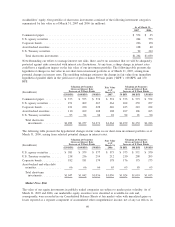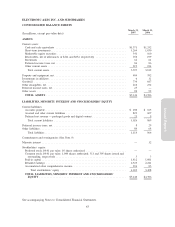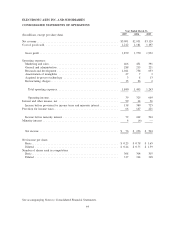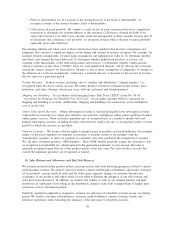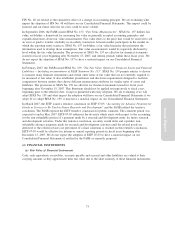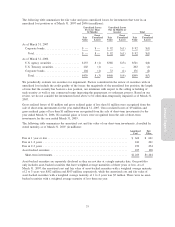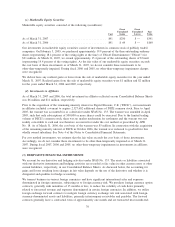Electronic Arts 2007 Annual Report Download - page 143
Download and view the complete annual report
Please find page 143 of the 2007 Electronic Arts annual report below. You can navigate through the pages in the report by either clicking on the pages listed below, or by using the keyword search tool below to find specific information within the annual report.
(h) Long-Lived Assets
We evaluate long-lived assets and certain identifiable intangibles for impairment, in accordance with Statement
of Financial Accounting Standard (“SFAS”) No. 144, “Accounting for the Impairment or Disposal of Long-
Lived Assets”, whenever events or changes in circumstances indicate that the carrying amount of an asset may
not be recoverable. Recoverability of assets is measured by a comparison of the carrying amount of an asset to
future undiscounted net cash flows expected to be generated by the asset. This may include assumptions about
future prospects for the business that the asset relates to and typically involves computations of the estimated
future cash flows to be generated by these businesses. Based on these judgments and assumptions, we
determine whether we need to take an impairment charge to reduce the value of the asset stated on our
Consolidated Balance Sheet to reflect its actual fair value. Judgments and assumptions about future values and
remaining useful lives are complex and often subjective. They can be affected by a variety of factors, including
but not limited to, significant negative industry or economic trends, significant changes in the manner of our
use of the acquired assets or the strategy of our overall business and significant under-performance relative to
expected historical or projected future operating results. If we were to consider such assets to be impaired, the
amount of impairment we would recognize would be measured by the amount by which the carrying amount
of the asset exceeds its fair value which is estimated by discounted cash flows. We recognized an insignificant
amount of impairment in fiscal 2007, 2006 and 2005.
(i) Taxes Collected from Customers and Remitted to Governmental Authorities
Taxes assessed by a government authority that are both imposed on and concurrent with specific revenue
transactions between us and our customers is presented on a net basis in our Consolidated Statements of
Operations.
(j) Concentration of Credit Risk
We extend credit to various companies in the retail and mass merchandising industries. Collection of trade
receivables may be affected by changes in economic or other industry conditions and may, accordingly, impact
our overall credit risk. Although we generally do not require collateral, we perform ongoing credit evaluations
of our customers and maintain reserves for potential credit losses. As of March 31, 2007 and 2006, we had
10 percent and 11 percent, respectively, of our gross accounts receivable outstanding with Wal-Mart Stores,
Inc. As of March 31, 2007, we had 11 percent of our gross accounts receivable outstanding with GameStop
Corp.
Short-term investments are placed with high quality financial institutions or in short-duration, investment-grade
securities. We limit the amount of credit exposure in any one financial institution or type of investment
instrument.
(k) Revenue Recognition
We evaluate the recognition of revenue based on the criteria set forth in SOP 97-2, “Software Revenue
Recognition”, as amended by SOP 98-9, “Modification of SOP 97-2, Software Revenue Recognition, With
Respect to Certain Transactions” and Staff Accounting Bulletin (“SAB”) No. 101, “Revenue Recognition in
Financial Statements”, as revised by SAB No. 104, “Revenue Recognition”. We evaluate revenue recognition
using the following basic criteria and recognize revenue when all four of the following criteria are met:
• Evidence of an arrangement. Evidence of an agreement with the customer that reflects the terms and
conditions to deliver products must be present in order to recognize revenue.
• Delivery. Delivery is considered to occur when a product is shipped and the risk of loss and rewards of
ownership have been transferred to the customer. For online game services, delivery is considered to
occur as the service is provided. For online services associated with our packaged goods products (other
than massively multiplayer online games) such as matchmaking, roster updates, tournaments and player
rankings, we estimate the service period to be six months after the month of sale.
Annual Report
69



